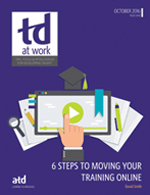ATD Blog
Translating Activities Into the Virtual Classroom
Thu Oct 27 2016

Often moving classroom activities for a virtual classroom is less about creating the actual content, and more about mapping out and creating the learner journey. That is, identifying the steps we want the learners to take and the workflow needed for the optimal learning journey. Let’s take a closer look.
Consider All Available Media
We have a lot of different media that we can leverage when we are putting together our digital learning journey, such as face-to-face training, virtual classrooms, e-learning, videos, podcasts, audiovisual presentations, reading materials, job aids, quizzes, and assessments. To generate a strong learning experience, we need to harness the collection of resources available to us.
To aid us in mapping out this digital learning journey, at Virtual Gurus we use something called a wireframe, a document that you may refer to as a design document or a storyboard. Whatever you call it, it should provide a high-level outline of what the course will contain, the topics to be covered, expected learning outcomes, activities you will use, and learning modalities.
When starting to create your wireframe, first consider the terminal objectives. A terminal objective is your learning outcome, the main goal you want to achieve with your training program. In other words, what is your learner going to do after the training? As we put together a learning journey, we want to break up the various components of the design so that we create a journey that is meaningful for the learner.
We need to rethink how we provide knowledge to our learners—something we can do more effectively and efficiently by providing the knowledge piece in an asynchronous or self-paced way. You can do this by giving learners a video or documents that they can watch or read beforehand, so they come to the session prepared to use that knowledge. This makes the best use of the time in the virtual classroom; learners take the knowledge piece and process it by getting involved in various discussions, role-plays, and scenarios.
Beyond the actual workshop, there will be a series of job performance aids. It’s also a good idea to support the learner’s line manager in coaching the learner, including a 360-feedback session.
A Strong Blend Supports the Learner
Many see blended learning as the combination of a face-to-face workshop and an e-learning course. We owe it to our learners and their organizations to create a strong blend that leverages multimedia and appeals to all learners and ways of learning. Note that when we use the term blended learning, we are referring to creating a digital learning journey that may consist of many different methods of delivering learning—face-to-face, virtual classroom, e-learning, discussion forums, bite-size learning.
Not only do our learners expect us to use all media available, but in doing so, we can construct learning experiences that can stimulate, motivate, and engage our learners in ways that we’ve not been able to do previously. Blended learning is more effective than purely face-to-face or virtual training, resulting in higher levels of student achievement than classroom-based learning alone, as reported in a February 2015 Get eTraining blog post.
Here’s a look at how some activities translate in a blended, virtual learning journey:
Facilitator-led brainstorm. Using the chat tool, ask learners to suggest ideas, which you can then summarize and debrief; alternatively, invite learners to write their ideas directly onto the whiteboard.
Case studies. Prepare a case study with detailed instructions, making them available in the breakout room. Assign learners to the various breakout rooms and invite them to collaborate on working through the case study. Then, bring the group back together and invite representatives from each group to present their solutions verbally.
Quizzes. Develop a series of questions with multiple-choice or yes-or-no answers and create a series of polls, which you can then run. Share the results with participants and then debrief the correct answers.
Group or plenary discussion. Provide a discussion question and show it on the screen or in the chat space. Invite participants to share ideas using chat or by raising their hand and speaking out verbally.
Group presentations. Give each group of learners a task (the same one or different ones), provide separate instructions and expected outcomes. Assign participants to the breakout rooms and invite them to use the different tools to complete the task or prepare a presentation to share with the rest of the group.
Provide Learners With Access to Content
Recent years have seen a huge increase in organizations using learning management systems (LMSs) to not only track and record the learner’s journey, but also provide access to the various components needed to support the learner through the journey. Providing simple access to the content is key.
An LMS that is difficult to navigate obviously is not very helpful. Learners should clearly understand what is required from them to complete the learning journey. This information allows them to manage their time and self-paced activities more effectively.
When creating this digital learning journey, the instructional designer or learning architect is likely to need to enlist the help of the “production crew,” which may be one person, depending on organization size. The production crew will have the skill set to create e-learning modules, videos, podcasts, job aids, and so forth.
**

For more on how to make the move to a virtual classroom, check out the new TD at Work “6 Steps to Moving Your Training Online****” (October 2016, ATD Press).**
You've Reached ATD Member-only Content
Become an ATD member to continue
Already a member?Sign In
